Before the international break, IFK Norrkoping hosted IK Sirius at the Östgotaparken. It was a huge clash as both teams had decent results at Allsvenskan this year. Nörrkoping and Sirius could have contended for playing in the UEFA Europa League in 2021/22.
In Uppsala, Henrik Rydström’s side acquired a 4-2 victory. Therefore, Jens Gustafsson tweaked the tactics slightly. This tactical analysis introduces the approaches of these two teams.
Lineups
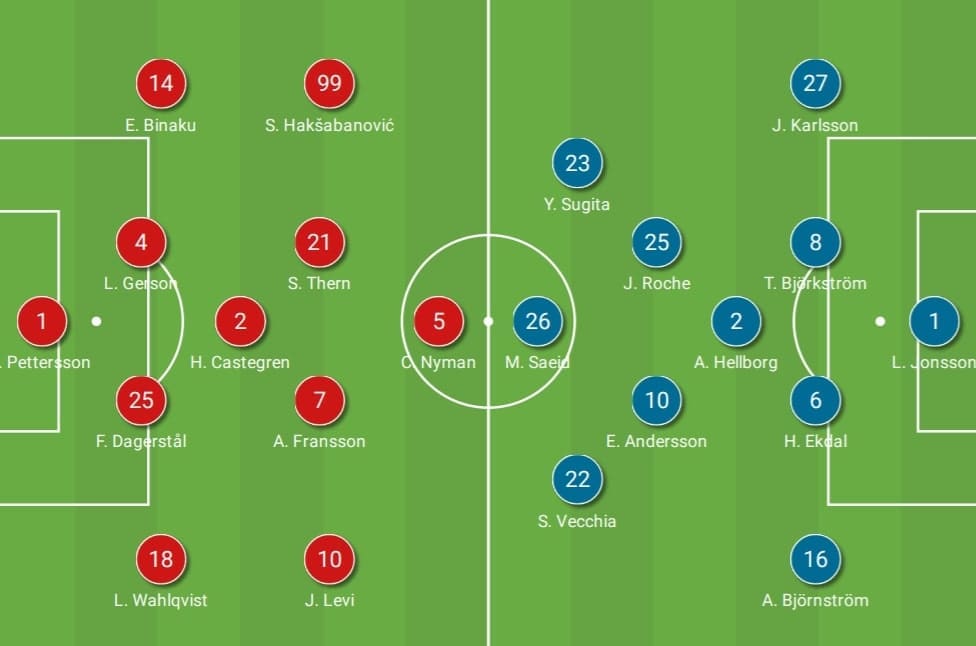
The away side slightly adjusted the team, as they welcomed Jonathan Levi and Lars Gerson back to the team, they replaced Ísak Bergmann Jóhannesson and Rasmus Lauritsen, who was now a GNK Dinamo Zagreb player. They were counting on Christoffer Nyman to continue his goal-scoring form.
As for Sirius, they missed Nahom Girmai Netabay at the midfield. Therefore, Jamie Roche partnered with Elias Andersson and Adam Hellborg as the trio. Another youngster – Johan Karlsson started as Karl Larson could not play the game.
Sirius in possession
This year, Sirius were trying to play very differently as Rydström has been implementing his positional plays philosophy into the team. The team looked better after overcoming some problems in the middle of the season. Even playing away from home, Blåsvart stuck to their own style regardless of the opponents.
Before digging into Sirius’ positional plays, it was important to understand the defensive system of the opponent. Nörrkoping were defending in a 4-1-4-1 or a 4-5-1, with a zone-oriented system and a midblock. The engagement line was relatively low, sometimes they even allowed the opponent to bypass the central third. The only rule of the setup was to keep the last line out of the penalty box, so to compress spaces at the high-defensive third.
Therefore, Sirius had to open their shape to stretch the pitch as big as possible. By doing so, the full-backs – Axel Björnström and Karlsson stayed high to occupy the wide zones. With the wingers inverting themselves narrowly, the team could still control all vertical zones while having enough numbers at the midfield.
The below image demonstrated the basic setups for both teams. One slight tweak was the role of Nörrkoping’s right-back – Linus Wahlqvist. To control Stefano Holmquist Vecchia, the most dangerous player in Sweden, his duty was slightly man-oriented, including behaviours such as stepping out early on the winger. Meanwhile, Nyman mostly protected the central zone to control the pivot. The rest should be patient to stay deep and compact, compressing areas to prevent the opponent from developing plays through the centre.
Apart from the wide full-backs as explained in the above analysis, Sirius also used a flexible approach to play out from the back. The shape was liked a 2-1-2-5, with Adam Hellborg occupying the striker. This could allow the Tim Björkström and Hjalmar Ekdal moving into the half-spaces, just like the wide centre-backs in a back three. Both should carry the ball over the first line of pressure.
To create passing options for the centre-backs, the ball-side winger and full-back should make themselves available in the build-up. In the first half, Sirius focused on attacking the right side. Yukiya Sugita always moved to the half-spaces, at the hole right behind the midfield to disguise the opponent. If Sead Hakšabanović stayed narrowly, Karlsson could be the free player to receive the ball. Or vice versa, Sugita, who was good at tight spaces, could be the point to develop an attack.
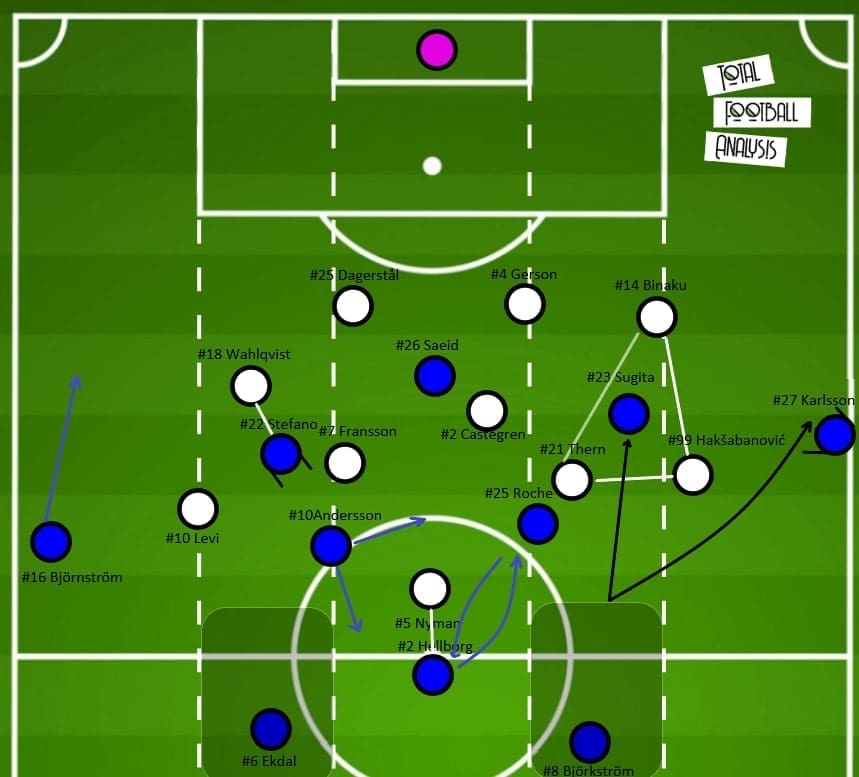
On some occasions, Nyman led the line to press the opponent. The below example demonstrates the zonal system of the team, as Thern moved out to press Björkström, who was on the same vertical channel.
However, the team shape was relatively deep. Hardly could the defending players reach the ball given the distances were far. The pressing mostly delays the build-up but not intense enough to regain possession at advanced areas.
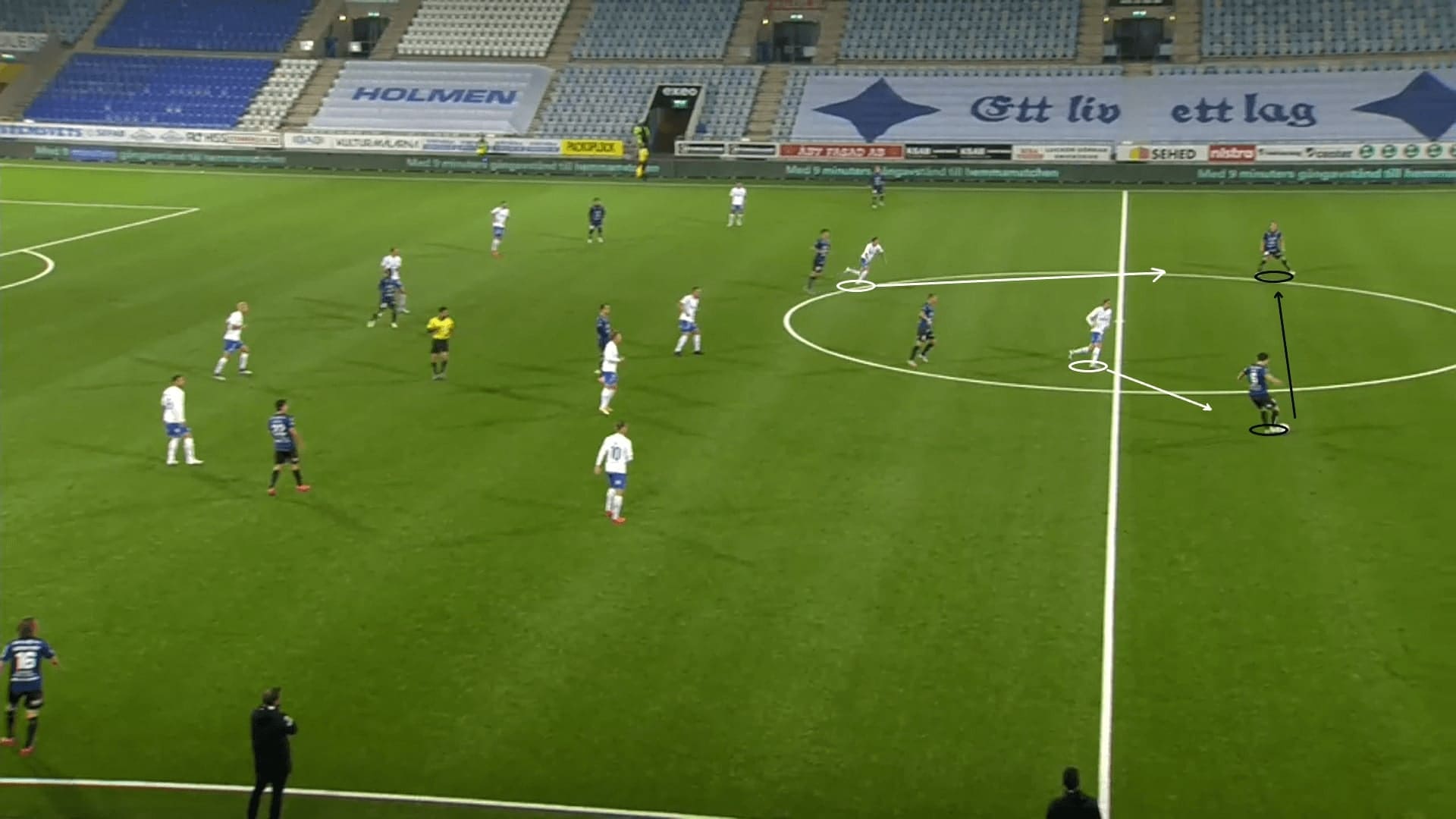
The next example was a typical build-up pattern of Sirius in the first 45. Since Hellborg kept Nyman at the centre, Björkström had spaces to bring the ball forward. Here, he had two options to choose – Sugita and Karlsson.
There was more than one attacking pattern available in this setup. Usually, Blåsvart tried to enter zone 18 quickly in these situations. Passing the ball to Sugita, the Japanese winger could quickly turn and release the overlapping right-back. This was capitalizing on the 2 v 1 numerical overload behind the midfield. Or, passing to Karlsson first, Sugita could make inside-out runs to support the ball, also ended up in the same zone. Mohammed Saeid and Vecchia should attack the penalty box on those occasions.
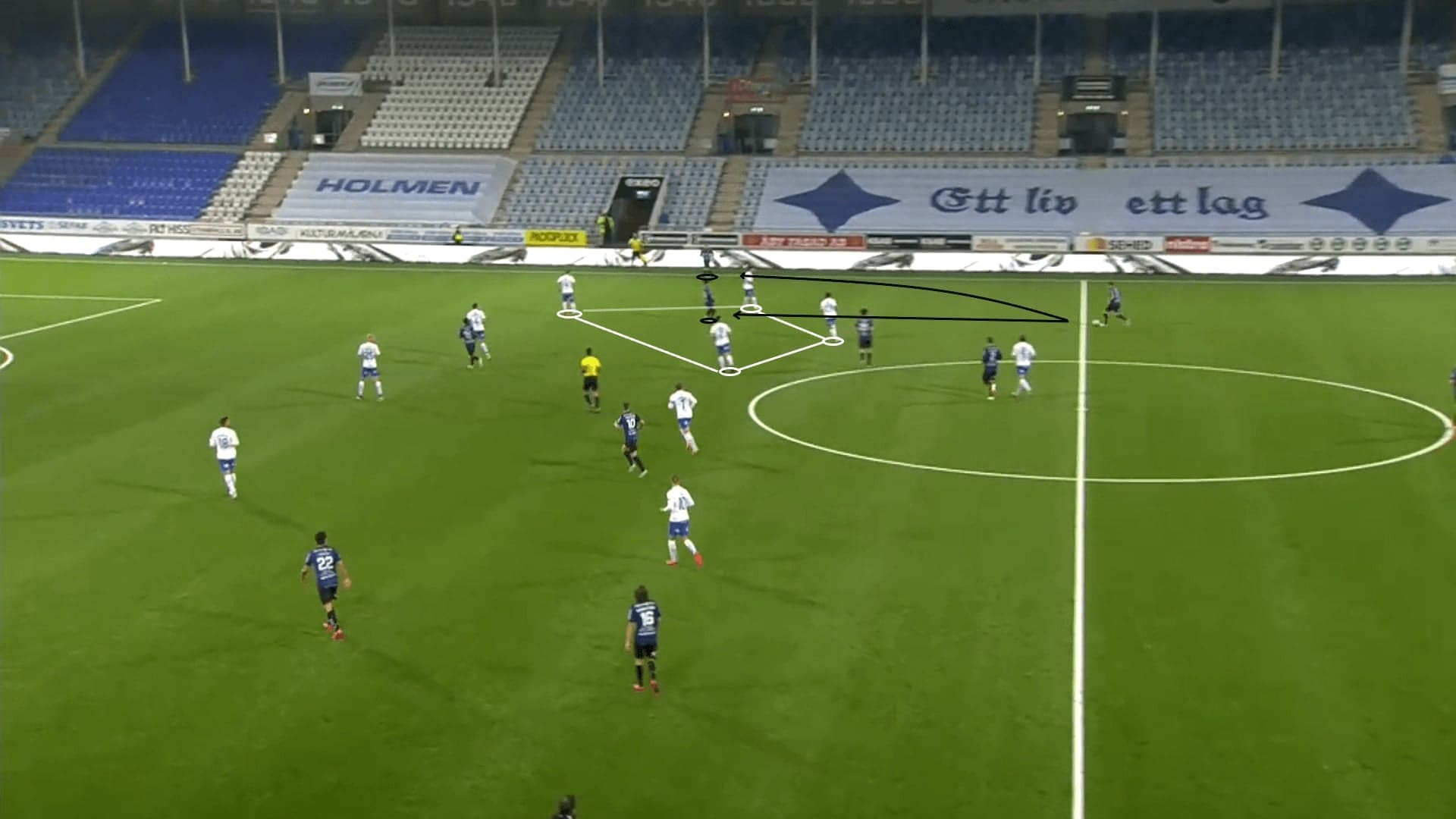
On the left, Sirius should have spaces to attack because of Wahlqvist’s behaviour on Vecchia. For example, the deep positioning of the left-winger has dragged the right-back out of position. Björnström was ready to attack the wide zone, also enjoying a 2 v 1 numerical superiority on Filip Dagerstål.
However, Blåsvart did not make these momentums counted in the first half. As one of the cases, Andersson did not release Björnström even a passing lane was available.
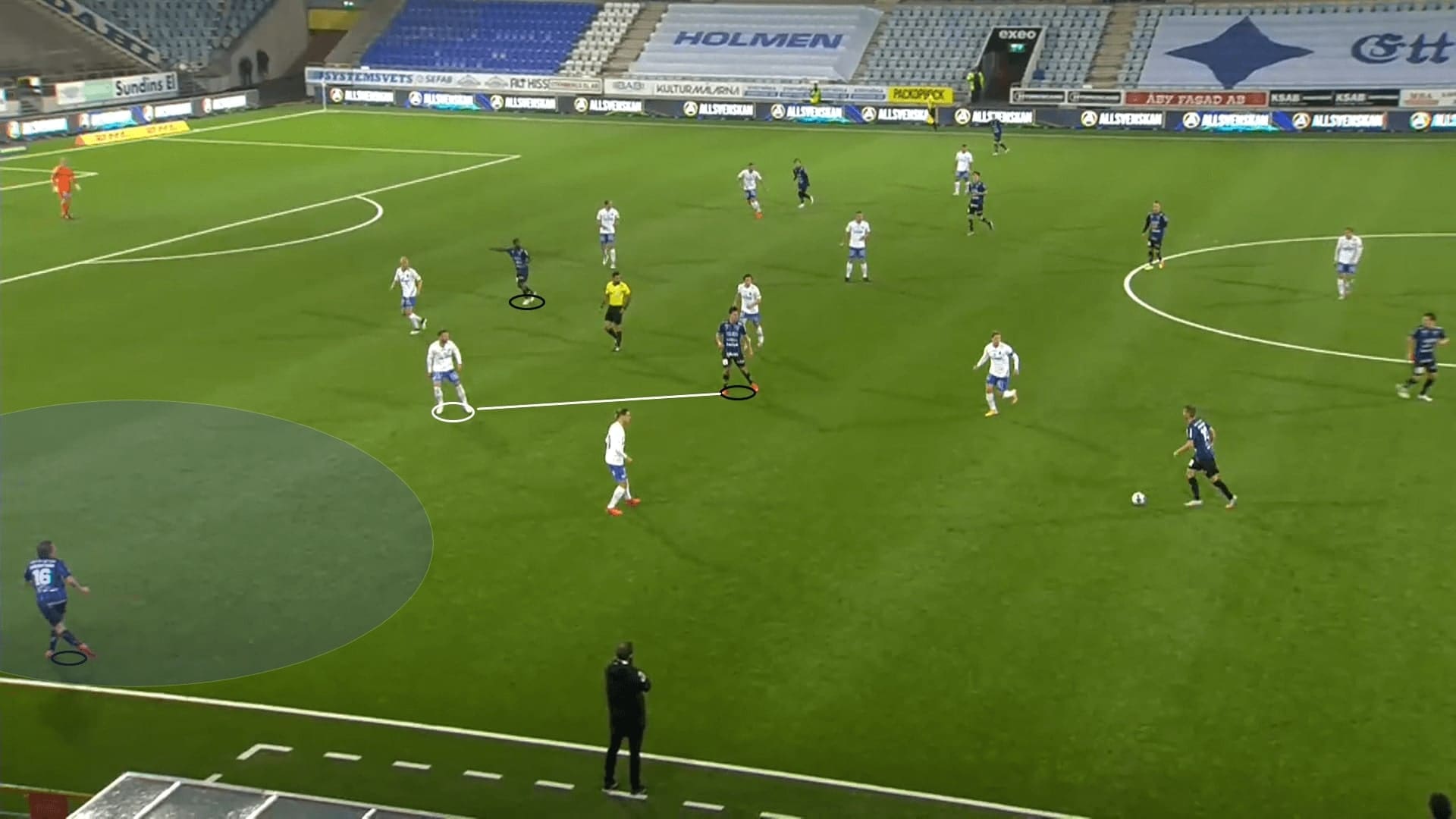
Getting Vecchia involved
The second half was a different story. Even the first half was fine, Rydström slightly tweaked the tactics to get Vecchia more involved in the game. The below formation sheets summarized changes of Sirius system as the game went on.
After the break, Sugita was given the free role to move into the centre. Hellborg was replaced by Laorent Shabani as the 21-year-old player now played as the right-winger. Andersson operated deeper, dropped to form a double pivot with Roche. Now, Sirius attacked another vertical half of the pitch, the attacking focus has changed.
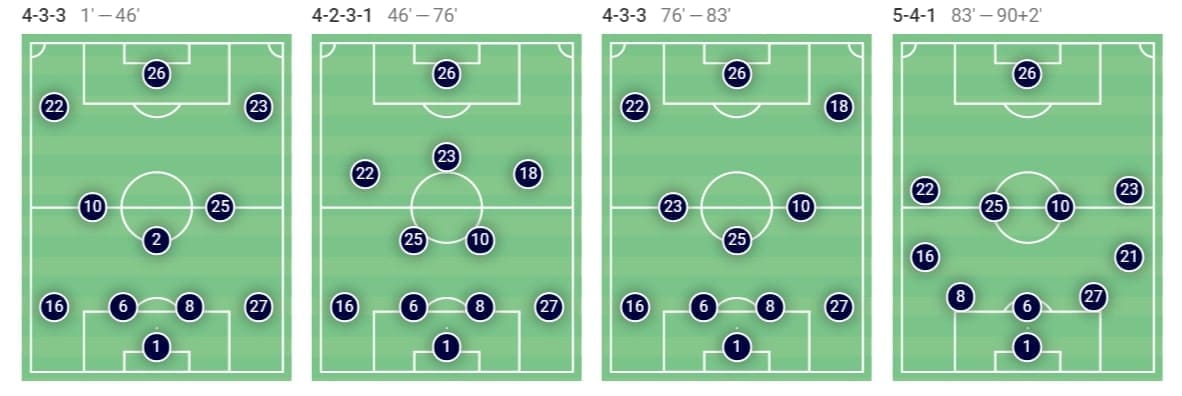
Since Nörrkoping were defending deeper in the second half, playing out from the pressure was not the main concern of the team. The approach was more aggressive as the team shape was more flattened to occupy higher areas on the pitch, it could be a 2-3-5 (below) or a 2-2-6.
Vecchia was doing a similar job as Sugita did on the other side in the first half. Inverting to the half-spaces, the left-winger should drop into the holes behind the midfield and between the lines. Using the same concept as explained, this offered at least two options for the ball.
Here, Vecchia appeared at the half-spaces, intended to keep Wahlqvist narrowly to open spaces for Björnström. Now, Andersson could have two options, and both were dangerous. Vecchia could turn and dribble, while the Björnström could provide the crosses in zone 16. This was how they created Saeid’s goal to seal the victory.
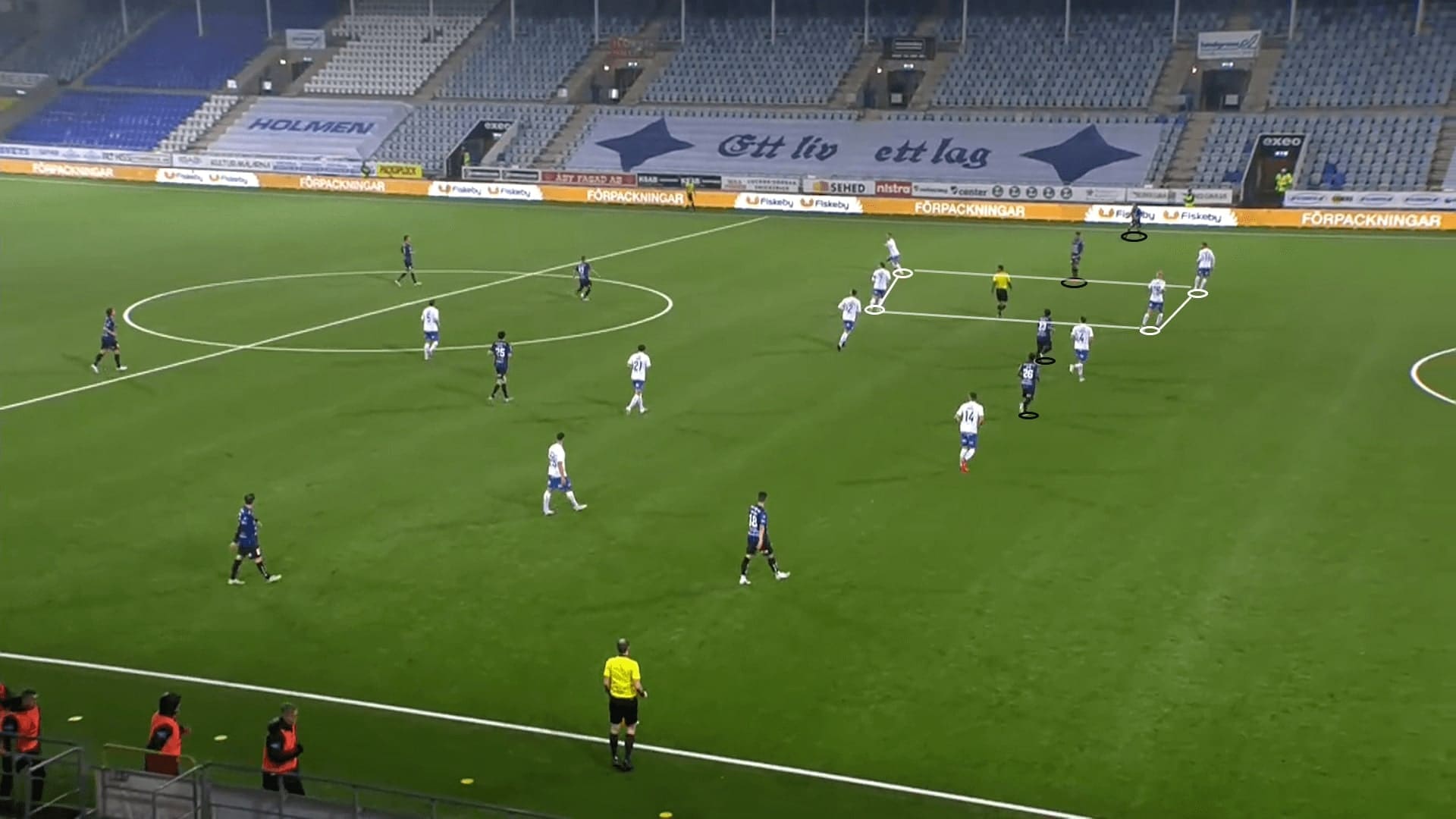
Also, the likes of Sugita and Saeid were given more freedom to roam their positions. For example, the striker moved wide to open a passing option for Andersson below. On other occasions, he dropped to the midfield to connect plays.
The idea was simple, as long as the winger providing the offensive heights, the players could interchange their positions to disguise the defenders. It might be even better to place Vecchia at the centre, as the winger has a strong goal-scoring sense in this campaign, as well as Sugita.
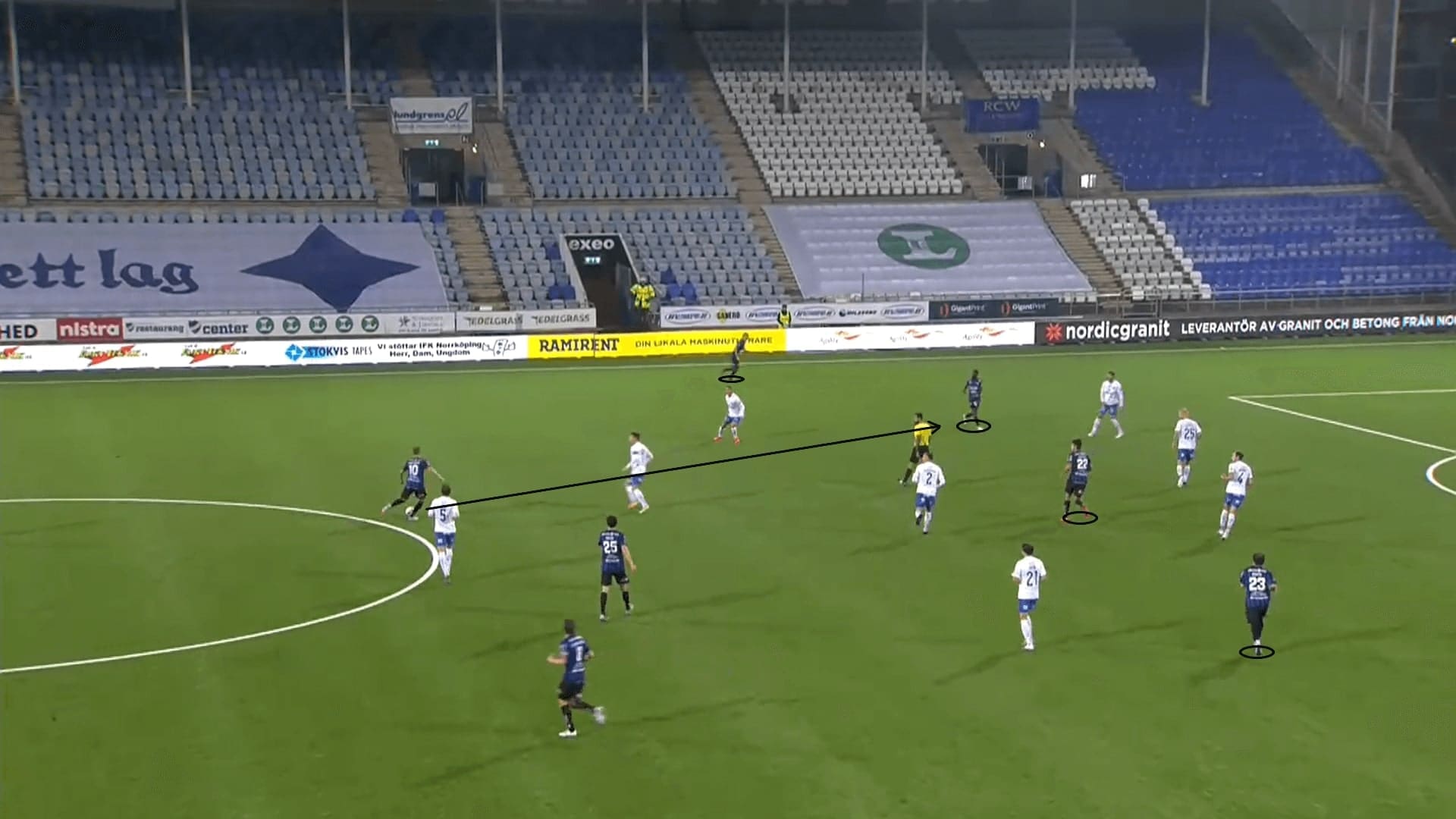
The below heat map belongs to Vecchia. The left-winger was not only having impacts at the wide zones. Instead, he stayed at the half-spaces more often in the final third, also covering areas outside of the penalty zone.
It was a clever approach as putting the most dangerous player at the centre could stay near the opposition goal. It was the similar role to Raheem Sterling at Premier League club Manchester City.
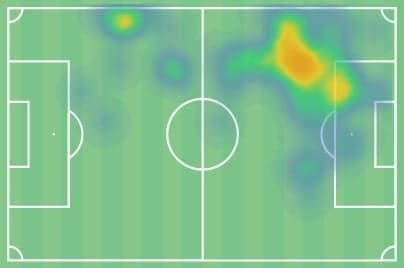
Nörrkoping escaped from the press
Defensively, Sirius also used a very similar approach that successfully troubled Nörrkoping’s build-up in the previous clash. The team defended in a 4-1-2-3, it was also zone oriented. The best part of the setup was the defensive runs of the pressing players. The front players must curve the runs when pressing, in the hopes of covering areas in the shadow.
Since Nörrkoping also used a 2-1 shape in the build-up, the positionings of players were a bit similar to the Sirius setup. Therefore, it was Sugita and Vecchia to defend the centre-backs in their corresponding zone. Meanwhile, Saeid should be shadowing Henrik Castagren while pressuring the centre-backs. Mostly he would try to cover Dagerstål to reduce the defensive burdens of Vecchia.
The below image has shown the setup and the optimal curve runs. Sirius intended to control the centre of the pitch by placing six players in the region. Therefore, it was of the essence for the wingers to shut the full-backs while pressing the centre-backs. However, the approach did not work well enough given the good distances maintained by Nörrkoping players.
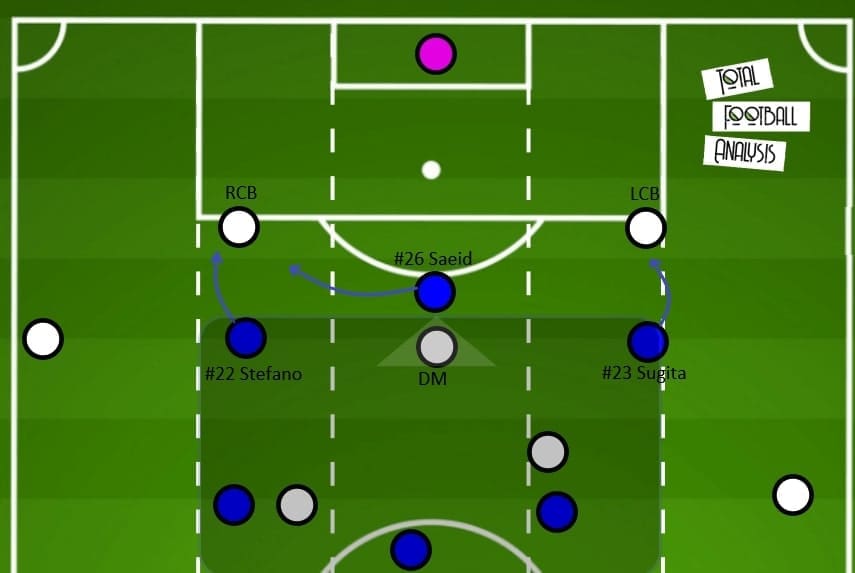
Apart from the 1-2 setup, the approach of Nörrkoping was slightly asymmetrical. Wahlqvist – the right-back was deeper than Egzon Binaku on the opposite side. He was often the player to escape from the press given there was no control on full-backs. All Sirius players stayed at the centre initially at the expense of leaving the wide zones with spaces.
Here, even Vecchia pressed with curved runs, it was not enough to shadow the right-back as the defending area was too big. Also, the left-winger seldom sprints with intensity to the target, which always allowing the opponents to escape with more time. The pass to Walhqvist was easily played.
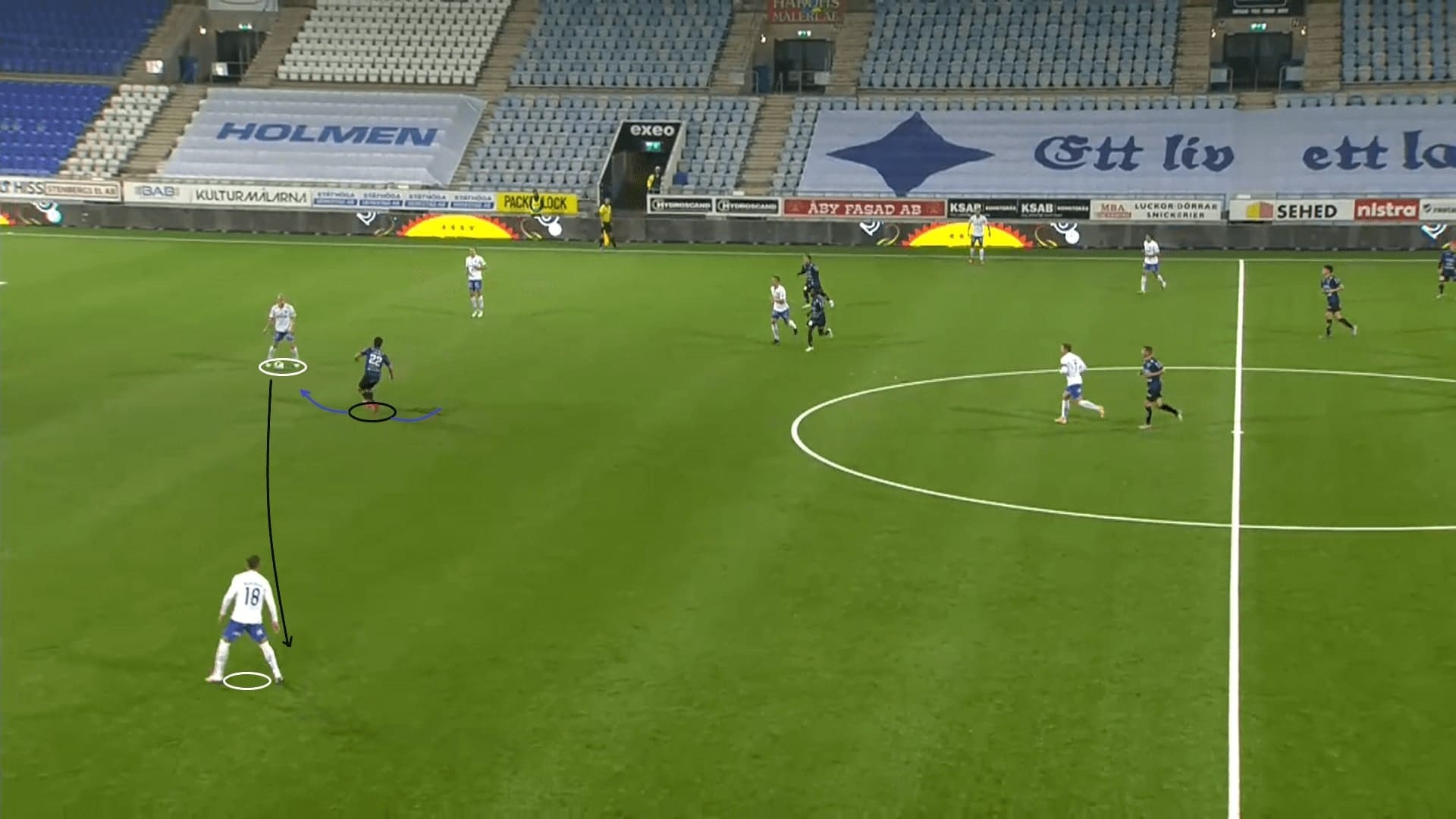
Below was another example of the unsuccessful pressing system of Sirius. The idea and setup were good, but the executions could be better. Sometimes the players did not by the timing of the press right or positioning themselves correctly when the opponent circulated the ball. Nörrkoping were patient to move the ball through from side to side through the defenders.
In the first half, sometimes Andersson and Saeid duplicated their duties when pressing. The block moved to high, leaving spaces behind the midfield. Nörrkoping successfully playing out from the back because of this.
Here, Saeid pressed but Vecchia did not do the same simultaneously. Therefore, Wahlqvist had time on the ball. Andersson moved up but eventually retreated as he noticed spaces needed protection behind him. Consequently, the pivot was unmarked to receive the ball. The passing route was shown by the black arrows.
Ideally, Saeid should consider re-pressing the right-back with sprints, this could have trapped the ball in the wide zones.
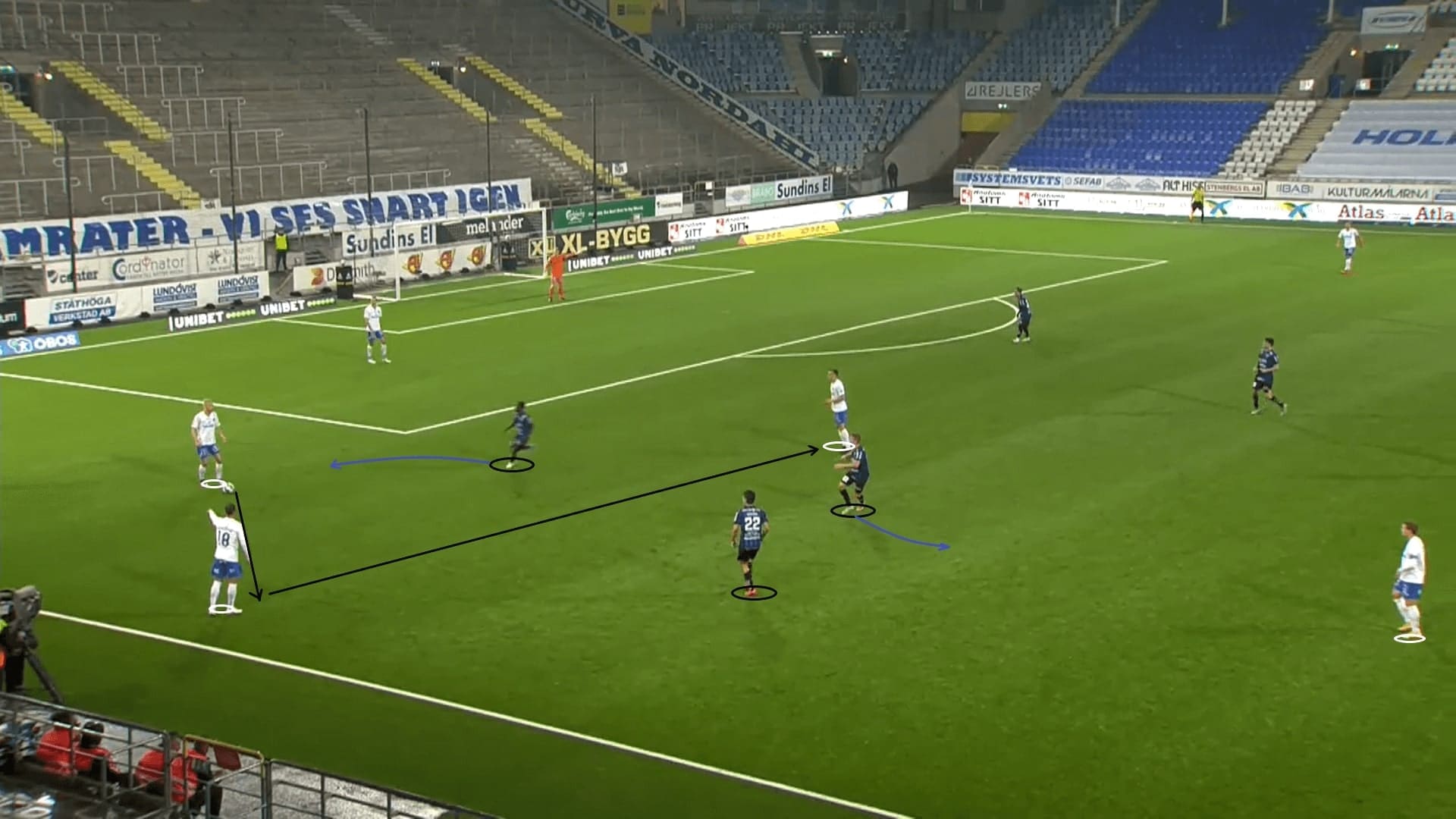
Despite bypassing the press, Nörrkoping relied on using the long balls to progress to much. They used the front players as the targets, mostly Nyman. There was no effective method to link the attacking players comfortably, especially Hakšabanović.
Below is the average positions and top passing links of Nörrkoping. The linkages between the centre-backs and right-backs, as well as Castegren. However, apart from the exchanges passes occurred at the backline, the front players were not well-connected.
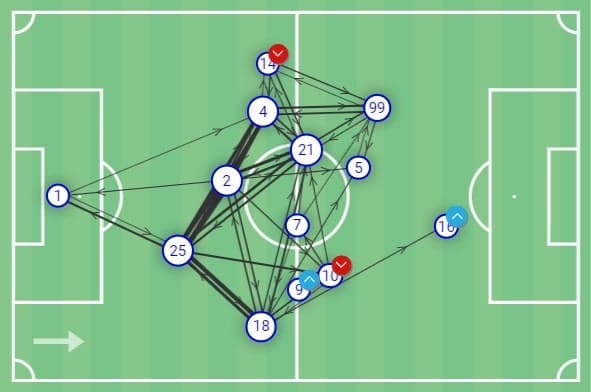
The structure in the first half was a bit too flat and lacked interconnectedness. The below image was an example, Nörrkoping left the central spaces unoccupied. Distances of players were quite far as well, it was difficult for them to support each other, or playing quick combinations to access the final third.
Therefore, Sirius players could anticipate when the passes travelled long distances. The situation might also go chaotic at the midfield given Peking players did not have clear qualitative superiorities to win in 1 v 1 situations. In this example, the central ball was intercepted by the opposition.
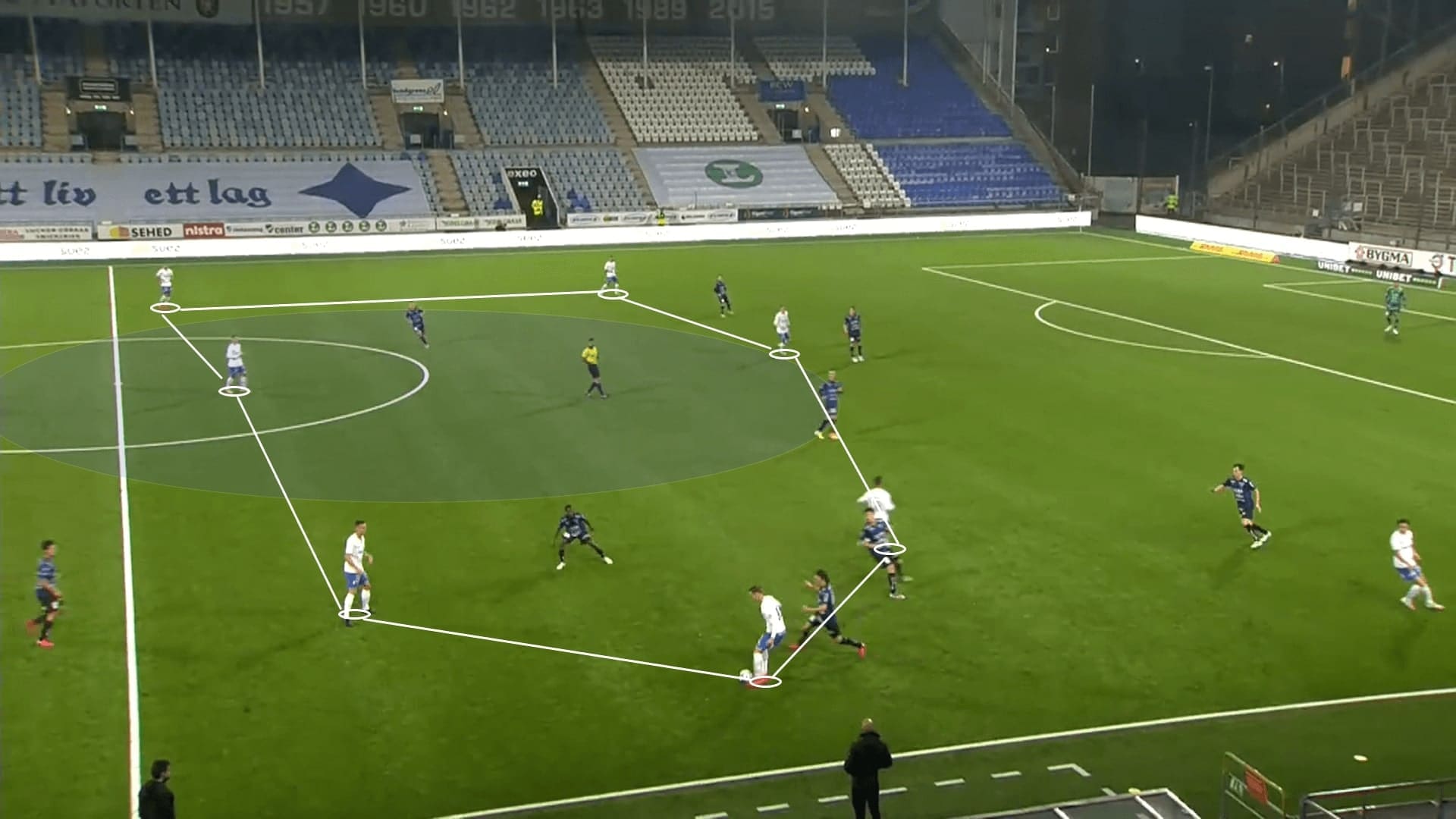
Gustafsson’s solution to the midfield struggle
Nörrkoping came back in the second half with slight tweak on the build-up. Now, Thern was the key player to initiate an attack, leading to various offensive patterns for the team. In the second half, Thern dropped deeper to the half-spaces, freeing himself out of the defensive block of Sirius to receive the ball. This could offer a passing option for the defenders without triggering the press of Sirius. Then, Thern could play with an opened body.
The below example was Thern dropping as another pivot or the wide centre-back. Sirius players were not catching him because of the deep positionings. Sugita was more focused on the centre-backs while Shabani did not want to leave his position.
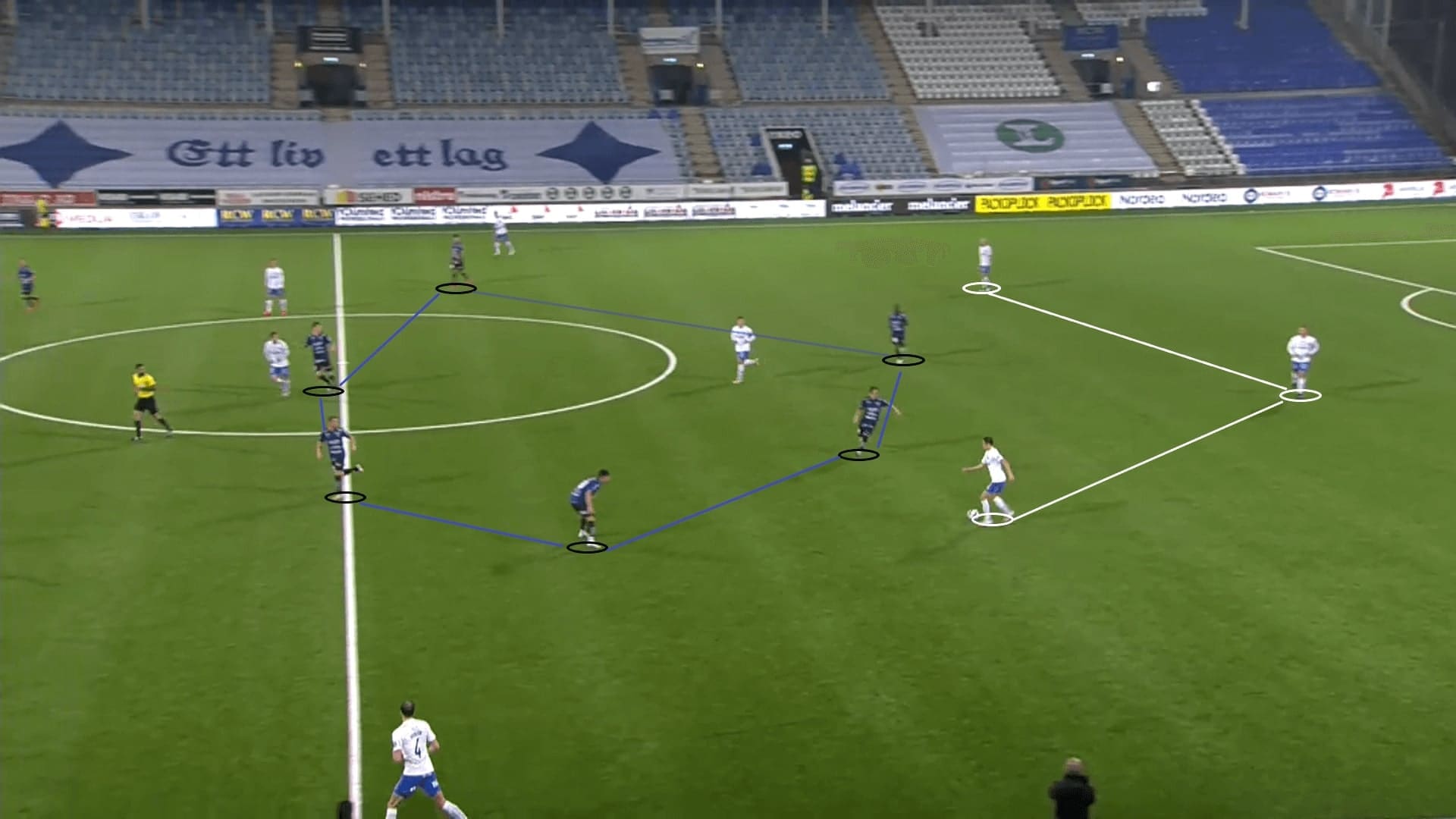
Another pattern still connecting Thern, but he would be receiving the ball at the opposition half, also at the half-spaces. The main idea was to free Hakšabanović to receive the ball at the outside of the right-back. Then, the former West Ham United winger could dribble inward to cross or shoot.
Below was an example – Thern receiving at the half-spaces, connecting Hakšabanović at the wide zone
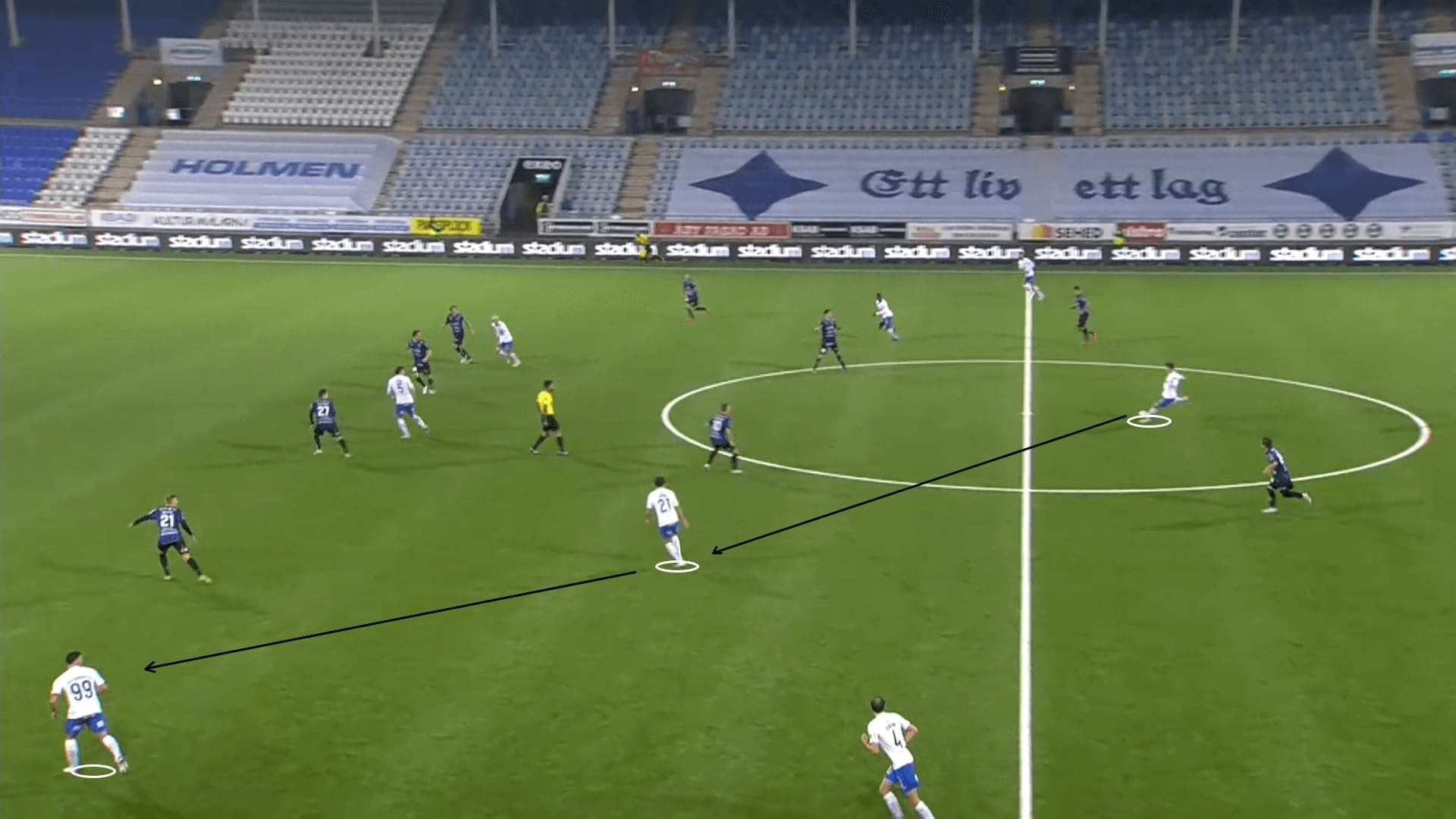
The last one shows the use of inside-out runners. Thern supported the left-back at the outside of the Sirius block. The supportive run was made by Hakšabanović, who came from the half-spaces. This was the least effective in terms of continuity, as the run lacked dynamics when the defenders tracked him. Perhaps more movements to attack depth should be made by Nyman to exploit the isolation of another centre-back to disguise the opponent.
Again, Sirius were unable to stop the attack from developing as the events happened at the outside of the defensive zones. Blåsvart’s pressing intensity dropped in the second half was another reason that contributed to the situations, the engagement line was deeper.
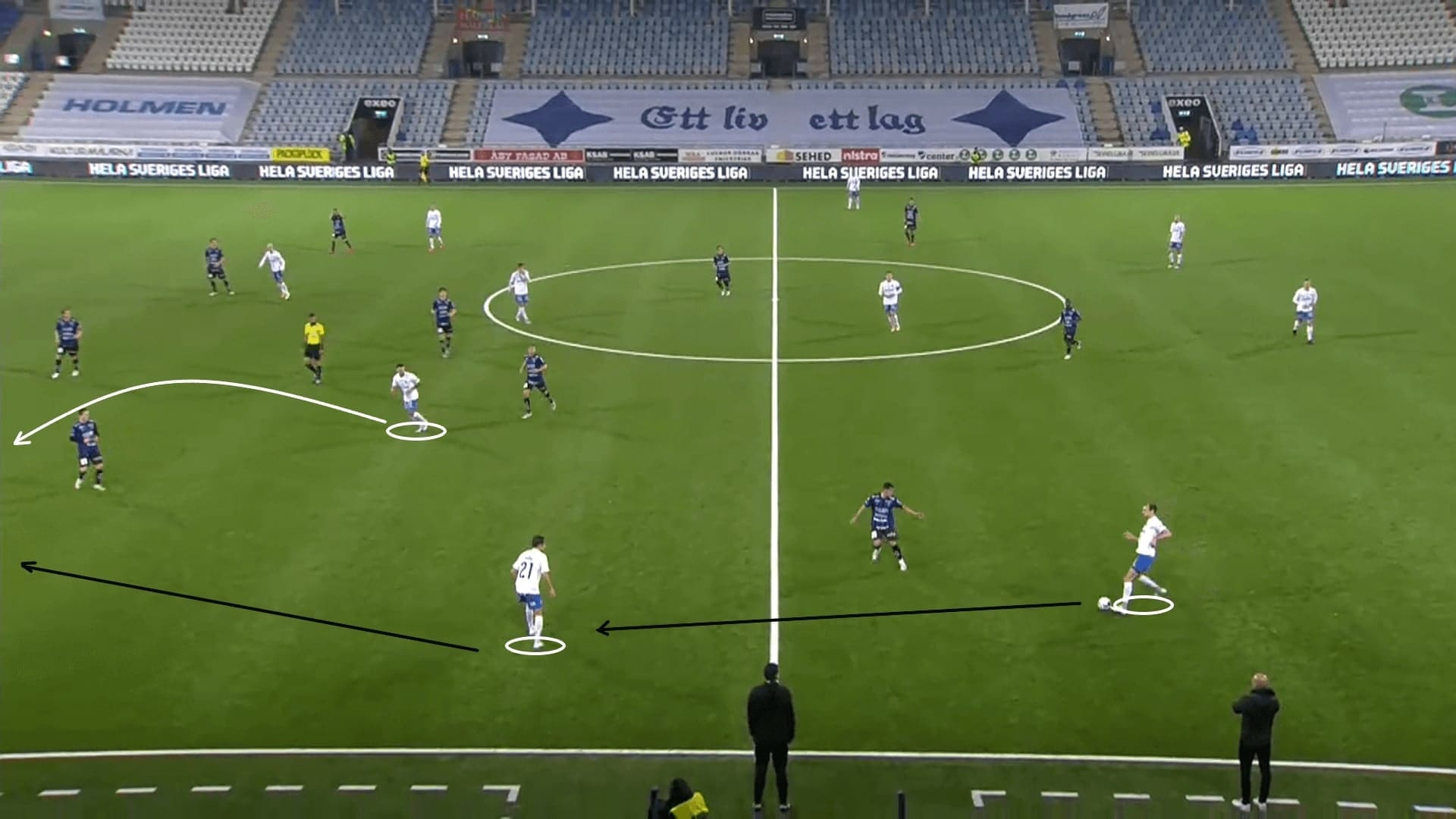
Final remarks
It was an exciting tactical battle. Nörrkoping tried to win the game but they relied on individual performance too much. Maybe using more combinations and patterns to attack in the final third could improve the effectiveness. Sometimes you could not just count on one or two players to shine in moments to win the game.
Sirius tried to dominate; the game was in-control until Saeid scored the goal. After that, the team seldom pushed up to commit many players to attack, and some moments could have done better than giving the ball away. This was the reason that Nörrkoping looked better at the closing period. In general, it was a good result for the team, as Sirius now saw the hope to enter European competitions.





Comments